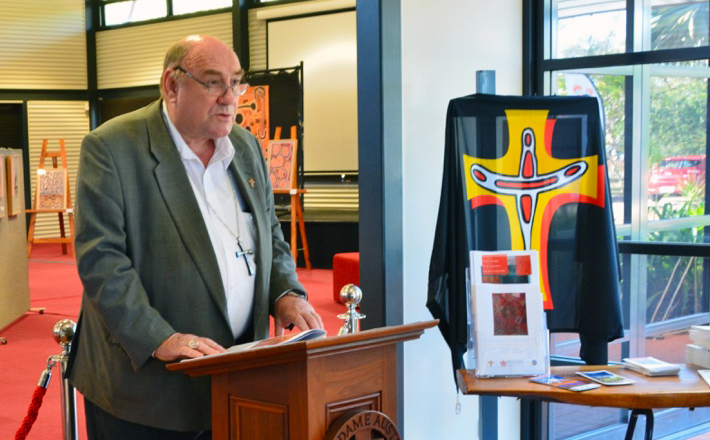
A number of assembly banners, painted by Aboriginal artists of the Balgo Hills, Kimberley region for the Jubilee of Father Peile SAC in 1981, were the focus of a recent art exhibition held in Broome.
The Balgo Banners and Christof Collection opened on Aboriginal Sunday, 5 July and continued until Monday, 13 July.
Sponsored by a partnership between the University of Notre Dame Australia, Broome Campus, and the Broome Catholic Diocese, the exhibition featured works from the Balgo Art Movement and its reflection of the cross-cultural exchange between Christianity and the Balgo community.
Balgo, or Wirrimanu in the local Indigenous language, is one of Australian’s most remote Aboriginal communities, located in the south-east Kimberley region of Western Australia. It lies on the northern edge of the Great Sandy Desert and on the western edge of the Tanami Desert.
The 400cm by 80cm banners, painted on calico using poster and acrylic paint, are considered to be the very first examples of what has now become the world-renowned Balgo Art Movement.
At the time in which they were painted, they influenced a number of individuals, many of whom had never painted before, to devote themselves to art and bring to life masterpieces depicting aspects of Indigenous culture and spirituality in the Kimberley.
Campus Minister at UNDA’s Broome Campus, Matthew Hill, stated that the great novelty of the exhibition lies in knowing that the Balgo Art Movement started with banners freely painted to celebrate the jubilee of a Catholic priest.
He also added that this sheds light on the rich history between Christianity and Aboriginal culture.
“These paintings reflect on the relationship between Indigenous people and the Church and show the development of this relationship over time,” Mr Hill said.
“Furthermore, they demonstrate the bond of trust between these early missionaries and the people of Balgo and the understanding that the Church was not there to erode their culture.
“In a time during which many remote communities, including Balgo, were under pressure from pastoralists and miners interested in land and resources, the Church was seen as a caring option.”
Mr Hill further emphasised the importance of the banners as works that initiated a passion for art and for the artistic representation of the meeting between the Church and Aboriginal culture.
“After the first banner was painted, younger men who had accepted Christianity and been baptised also created a banner with the help of senior lawmen. Cultural symbols were depicted along with crosses and other Christian symbols.
“Eventually, paintings emerged that went beyond cultural stories and started telling the stories of the adopted Catholic faith. For instance, some banners were painted, telling the story of Christmas and Easter but still using symbols and iconography of their traditional style,” Mr Hill said.
The work displayed at the exhibition is part of the Christof collection, which is the Catholic Diocese of Broome’s art collection.
The intention of this collection is to enable artwork from the Kimberley to remain in and for the people of the region. The Christof collection will also be on tour throughout the Kimberley in 2016 as the Diocese celebrates its 50th anniversary.
The artwork is not for sale.
More Photos:
[gdl_gallery title=”unda-broome” width=”150″ height=”150″ ]